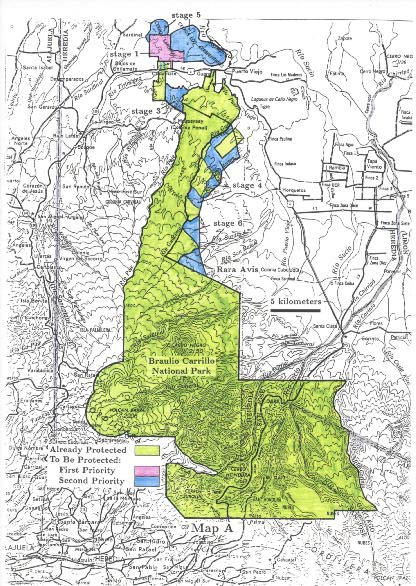
Sarapiqui; is a ``canton'' (county) in the northeastern province of Heredia, Costa Rica. It occupies 85% of the total land area of the Heredia Province. The town of Puerto Viejo is the population center and political seat of the Sarapiqui; county. It is located at the confluence of the Sarapiqui; and Puerto Viejo rivers, 30 kilometers south of the Nicaraguan border. The town is in an area that was formerly lowland rain forest. The land to the south rises very gradually to 3,000 meters in elevation over a distance of 35 kilometers.
Sarapiqui; has been a center of conservation activity in Costa Rica for many years, originally due to the presence of La Selva just south of Puerto Viejo. La Selva is the international biological research station owned by the Organization for Tropical Studies, a consortium of approximately 50 universities in the United States and Costa Rica. La Selva works closely with the surrounding community by involving them directly in the research being carried out by using their farms as study sites while at the same time educating them in new conservation techniques, new viable native species for reforestation, etc. La Selva also offers a course to train locals as naturalist guides.
In the 1980s, the Braulio Carrillo National Park was created in the mountains to the south of La Selva. The Park was subsequently extended 20 kilometers northward to connect with the research station. This extension was accomplished through an international effort that raised two million dollars, which included a one million dollar challenge grant from the John D. and Catherine T. MacArthur Foundation. The protected areas in the central region of Sarapiqui; are highlighted in green on map A.

The Braulio Carrillo National Park and its extension occupy the heart of the Sarapiqui; county and have formed the nucleus for a variety of conservation efforts and nature tourism projects. FUNDECOR (the Foundation for the Development of the Central Volcanic Mountain Range -- translated from its name in Spanish) works closely with land owners in the area promoting sound farm management techniques and conservation practices. COMBOS (The Conservation and Management of Tropical Forests) is also helping community groups and private individuals in the area with various projects promoting the conservation and management of private forests. ABAS (The Association for the Environmental Well being of Sarapiqui;) is a strong environmental group working in the Sarapiqui; region to halt the poaching of endangered animals, hazardous waste dumping by local banana plantations, and in general, watching for any other environmental offenses which exist in the region while at the same time promoting conservation of the rich natural resources of the area and consolidation of the Maquenque National Park at Caño Tambor.
Various nature tourism projects include Selva Tica, Islas del Rio, Rancho Leona which provides kayak trips on the Sarapiqui; River, Rara Avis, Selva Verde and their community learning center, various individuals with small private reserves, and entrepreneurs selling ``eco-art'', secondary products from the forest, etc. The most well known of these projects are ``Rara Avis of Costa Rica'', owned by Amos Bien (a North American) and ``Selva Verde Lodge'', owned by Giovanna Holbrook and Juan Holbrook (North Americans), Gainesville, Florida-based tour operators.
A problem which exists for the nature tourism businesses in the area is that the lower elevations of the Braulio Carrillo National Park are difficult to access, making it inconvenient for direct use by the nature tourism projects. For example, the Rara Avis property borders directly on the Park, however, access to the hotel involves a ride in a tractor-pulled cart that takes four hours, more if it is raining. There are also a number of small nature tourism projects in the region which include no forest of their own and, therefore, cannot offer forest access to their clients. La Selva is for scientific use and Selva Verde Lodge is only available to residents and guests of the Lodge. The Park itself is too remote for tourists to access easily.